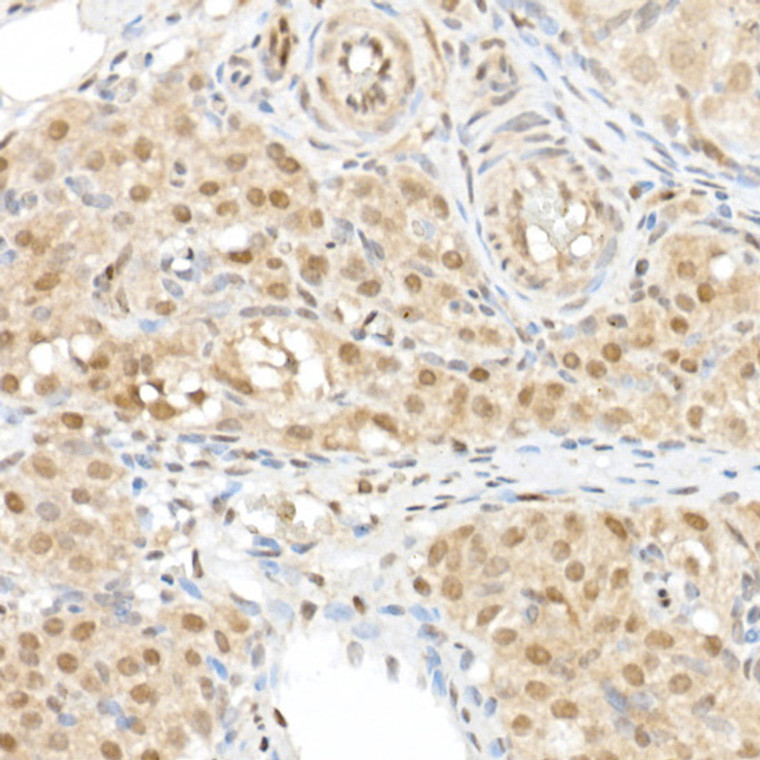| Host: |
Rabbit |
| Applications: |
WB/IHC/IF |
| Reactivity: |
Human/Mouse/Rat |
| Note: |
STRICTLY FOR FURTHER SCIENTIFIC RESEARCH USE ONLY (RUO). MUST NOT TO BE USED IN DIAGNOSTIC OR THERAPEUTIC APPLICATIONS. |
| Short Description: |
Rabbit polyclonal antibody anti-TAZ (1-400) is suitable for use in Western Blot, Immunohistochemistry and Immunofluorescence research applications. |
| Clonality: |
Polyclonal |
| Conjugation: |
Unconjugated |
| Isotype: |
IgG |
| Formulation: |
PBS with 0.05% Proclin300, 50% Glycerol, pH7.3. |
| Purification: |
Affinity purification |
| Dilution Range: |
WB 1:100-1:500IHC-P 1:50-1:200IF/ICC 1:50-1:200 |
| Storage Instruction: |
Store at-20°C for up to 1 year from the date of receipt, and avoid repeat freeze-thaw cycles. |
| Gene Symbol: |
WWTR1 |
| Gene ID: |
25937 |
| Uniprot ID: |
WWTR1_HUMAN |
| Immunogen Region: |
1-400 |
| Immunogen: |
Recombinant fusion protein containing a sequence corresponding to amino acids 1-400 of human TAZ (NP_056287.1). |
| Immunogen Sequence: |
MNPASAPPPLPPPGQQVIHV TQDLDTDLEALFNSVMNPKP SSWRKKILPESFFKEPDSGS HSRQSSTDSSGGHPGPRLAG GAQHVRSHSSPASLQLGTGA GAAGSPAQQHAHLRQQSYDV TDELPLPPGWEMTFTATGQR YFLNHIEKITTWQDPRKAMN QPLNHMNLHPAVSSTPVPQR SMAVSQPNLVMNHQHQQQMA PSTLSQQNHPTQNPPAGLMS MPNALTTQQQ |
| Tissue Specificity | Highly expressed in kidney, heart, placenta and lung. Expressed in the thyroid tissue. |
| Post Translational Modifications | Phosphorylated by LATS2 and STK3/MST2. Phosphorylation by LATS2 results in creation of 14-3-3 binding sites, retention in the cytoplasm, and functional inactivation. Phosphorylation results in the inhibition of transcriptional coactivation through YWHAZ-mediated nuclear export. Ubiquitinated at Lys-46.leading to proteasomal degradation. Deubiquitinated and stabilized by UCHL1 at Lys-46.leading to osteoclastogenesis inhibition. |
| Function | Transcriptional coactivator which acts as a downstream regulatory target in the Hippo signaling pathway that plays a pivotal role in organ size control and tumor suppression by restricting proliferation and promoting apoptosis. The core of this pathway is composed of a kinase cascade wherein STK3/MST2 and STK4/MST1, in complex with its regulatory protein SAV1, phosphorylates and activates LATS1/2 in complex with its regulatory protein MOB1, which in turn phosphorylates and inactivates YAP1 oncoprotein and WWTR1/TAZ. WWTR1 enhances PAX8 and NKX2-1/TTF1-dependent gene activation. In conjunction with YAP1, involved in the regulation of TGFB1-dependent SMAD2 and SMAD3 nuclear accumulation. Plays a key role in coupling SMADs to the transcriptional machinery such as the mediator complex. Regulates embryonic stem-cell self-renewal, promotes cell proliferation and epithelial-mesenchymal transition. |
| Protein Name | Ww Domain-Containing Transcription Regulator Protein 1Transcriptional Coactivator With Pdz-Binding Motif |
| Database Links | Reactome: R-HSA-2028269Reactome: R-HSA-2032785Reactome: R-HSA-2173795Reactome: R-HSA-2173796Reactome: R-HSA-5578768Reactome: R-HSA-8940973Reactome: R-HSA-8951671Reactome: R-HSA-9619665 |
| Cellular Localisation | NucleusCytoplasmCell MembraneConcentrates Along Specific Portions Of The Plasma MembraneAnd Accumulates In Punctate Nuclear BodiesWhen PhosphorylatedIs Retained In The Cytoplasm By YwhazCan Be Retained In The Nucleus By Med15Localized In The Cytoplasm In Areas Of Epithelial Cell High DensityAt Blastocyst Stage Expressed In The Nucleus In Trophectodermal CellsHowever Expressed In The Cytoplasm In The Inner Cell Mass |
| Alternative Antibody Names | Anti-Ww Domain-Containing Transcription Regulator Protein 1 antibodyAnti-Transcriptional Coactivator With Pdz-Binding Motif antibodyAnti-WWTR1 antibodyAnti-TAZ antibody |
Information sourced from Uniprot.org
12 months for antibodies. 6 months for ELISA Kits. Please see website T&Cs for further guidance














